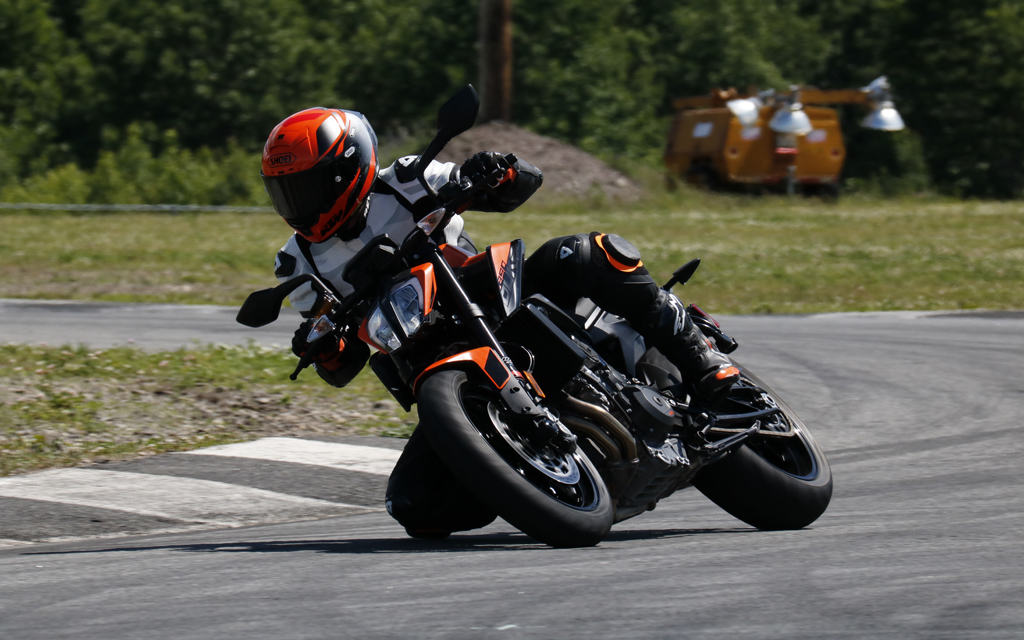*This article was published in Vol. 51 No. 7 of Cycle Canada digital magazine.
A SHARPER SCALPEL
FUN AND HIGH PERFORMANCE IN A MIDDLEWEIGHT
The Duke 790 is dead! Long live the 890 Duke! The opportunity was too good to be missed. So at the end of June I took advantage of fine weather to try out the new Duke on the road and on track.
When the prototype of the Scalpel was launched at the Milan EICMA Show in 2016, I was immediately seduced by the rebel roadster. KTM’s design studio, Kisha, gave it sharp lines that contrasted with the more classic aesthetics of other roadsters and set it apart from the production of that era. The Duke 790 radiates performance and delinquency. And competition.
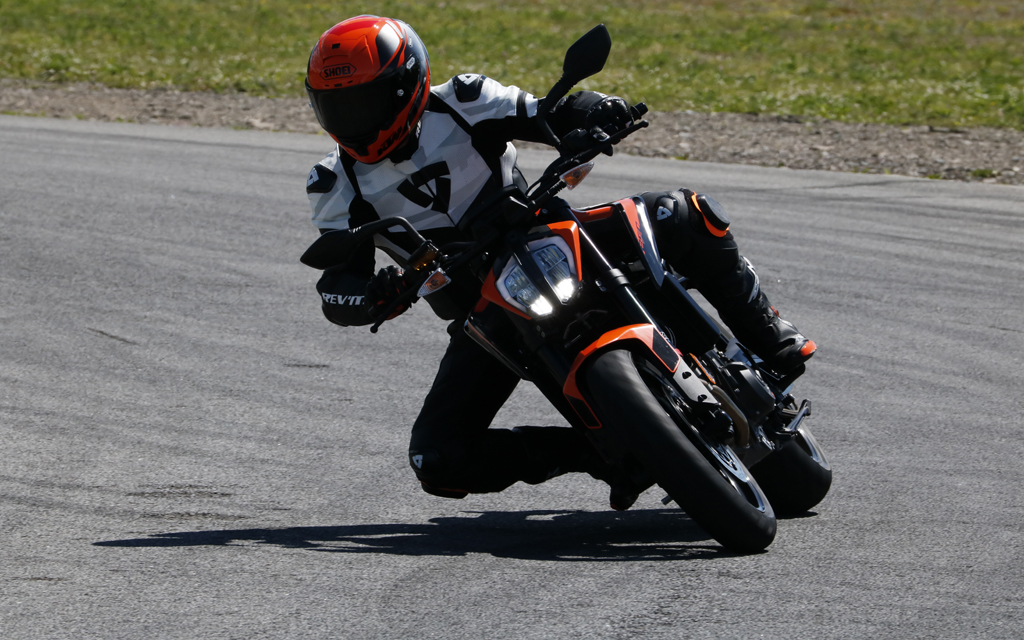
To demonstrate the Scalpel’s sporty nature, the French importer created the 790 Duke Cup, a single brand championship integrated into the Coupe de France Roadster Cup WERC. Ready To Race!
That made me even more eager to try it.
The occasion finally came in the spring of 2019 with the Scalpel’s North American introduction, two years after Europe. The spirited LC8 twin and the chassis were up to expectations, but the Duke got mixed reviews from the specialized press because of tires unfit for its pedigree (Maxxis Supermaxx ST) and its perfectible suspension. The Scalpel was somewhat blunt. Not as sharp as expected.
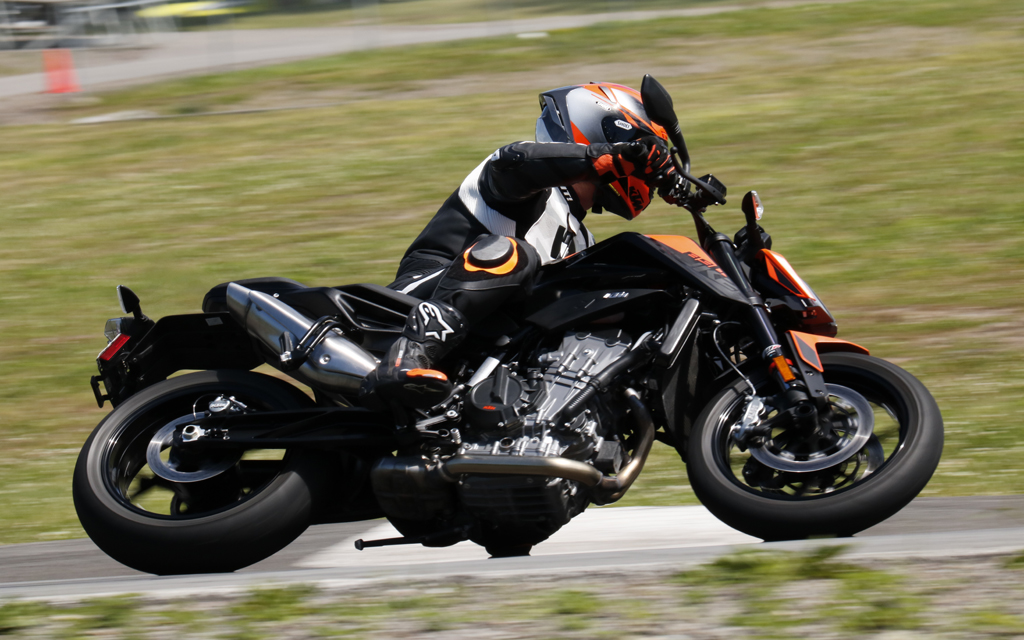
That being said, motorcyclists did appreciate the machine. But KTM was aware of its shortcomings and was going to react quickly.
In 2020, the Mattighofen firm had completed its homework and introduced the 890 Duke R, a track-oriented model that corrected the early shortcomings of the 790. The R came with a more temperamental engine and, more importantly, high-spec fully adjustable WP Apex suspension and ultra high-performance Michelin Power Cup 2 tires. All this for only $1000 more. A very good deal, indeed.
At this point, one would have thought that this “Ready To Race” 890 R would become the only middleweight Duke in KTM’s catalogue. But no! At the end of 2020, the Austrian company decided to launch the 890 Duke, a base model with higher specs and a lower price tag than its predecessor. It is offered at $11,899, which is $550 less than the 790.
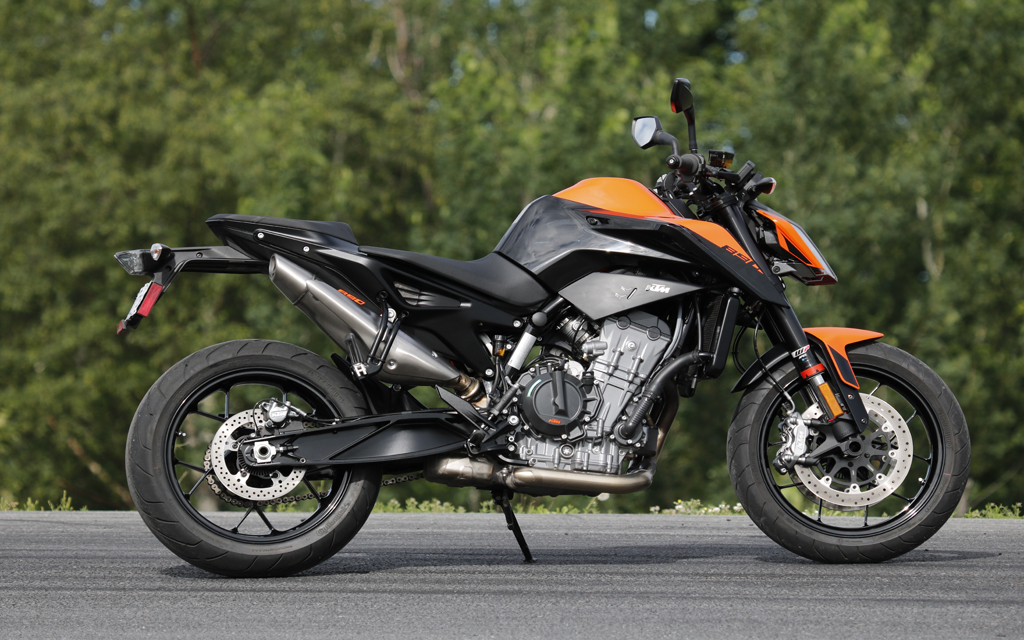
Beneficial changes
Under the European regulations, the 890 Duke had to adopt a Euro 5 engine, with a bigger displacement (+ 100 cc) to compensate for the castrating effects of the new standard. It puts out 115 hp at 9,000 rpm along with a maximum torque of 68 lb-ft at 8,000 rpm. That places it halfway between the vertical twin of the 790 (105 hp, 65 lb-ft) and that of the 890 Duke R (126 hp, 73 lb-ft). According to KTM, inertia is up 20% in order to improve low- and mid-range response.
The electronic arsenal is even more complete now with different user customizable modes and three preset modes (Sport, Road, Rain), plus an optional Track mode that can be configured according to the track and the pilot’s preferences. The MTC traction control and rear wheel slip control MSR (Motor Slip Regulation) systems offer nine levels of adjustment, anti-wheelie can be disabled and the response of the ride-by-wire throttle command is adjustable on three levels. A lean angle sensor allows the six-axis Inertial Measurement Unit to transmit a lot of information and data on the behaviour and positioning of the motorcycle to optimize available information.
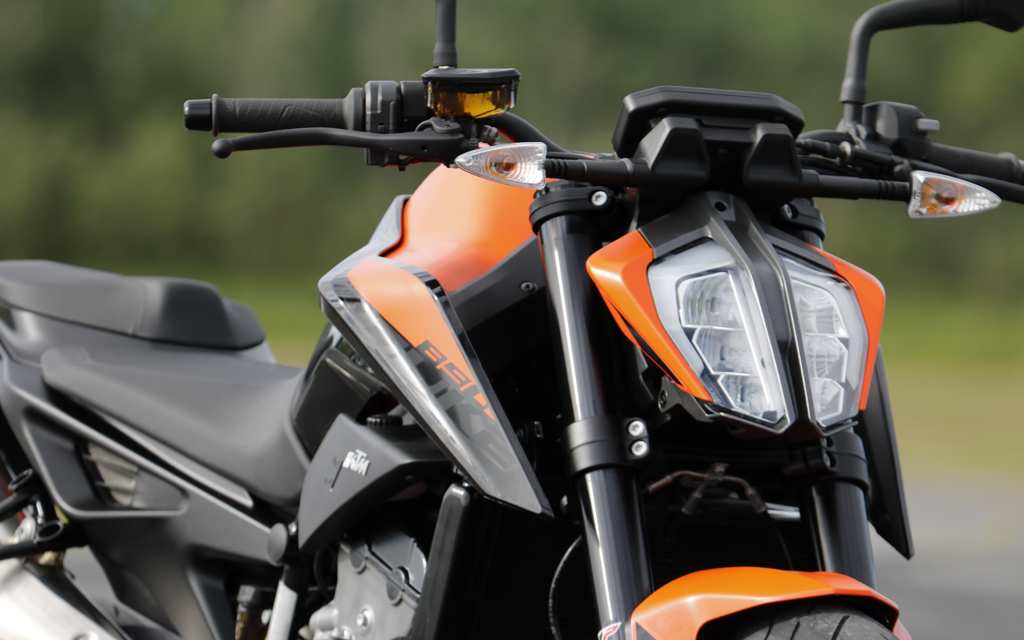
Instead of the premium suspension of the R, the 890 Duke is equipped with a non-adjustable 43 mm WP Apex fork, and a gas monoshock with spring preload adjustment. The suspension tuning has been optimized and there are new valves and softer springs for a more comfortable ride on the road.
Braking performance has not been forgotten and is also improved. The 890 is fitted with KTM calipers, built by J. Juan, like on the 790, instead of the superlative Brembo Stylemas of the R. New brake pads give more bite and generate efficient braking power on the road as well as on a racetrack.
Finally, the Maxxis Supermaxx ST of the 790 are replaced with Continental ContiRoad. These sport/touring tires deliver better performance and feel safe on dry as well as wet surfaces.
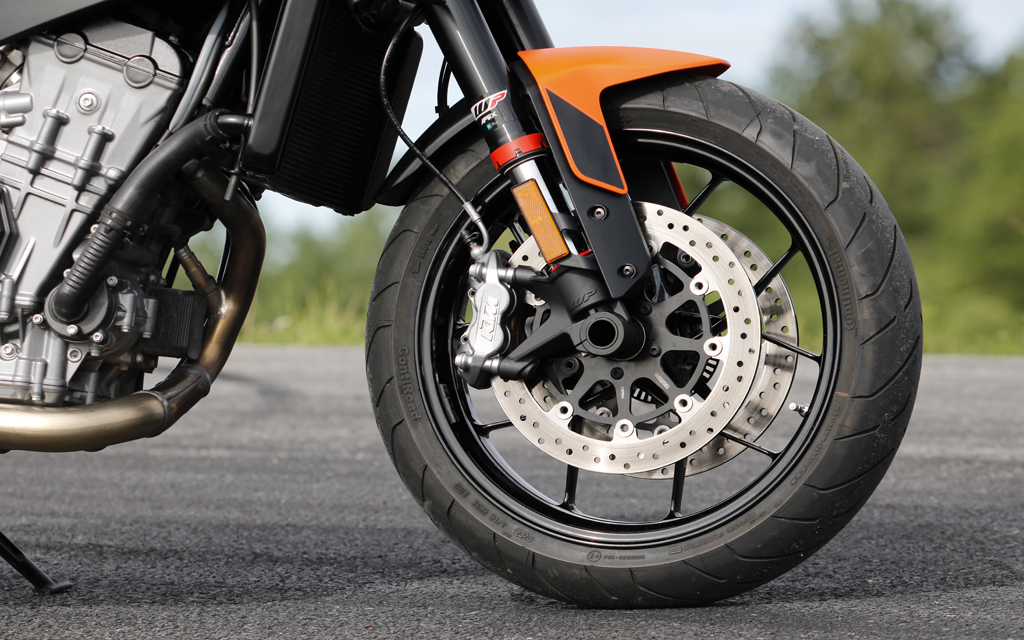
As for looks, the new KTM 890 Duke keeps the very same style as its predecessors. Everything is similar except colours and graphics. Some will appreciate this visual filiation, others will regret that KTM did not take this opportunity to redesign its middleweight roadster and give it a new identity, especially since the competition is going through a relooking process headed by the Ducati Monster that just got a nice lifting. So the 890 Duke is still easily recognizable with its clean style, sharp cut and chiselled lines and high-quality finish.
The road verdict
Regarding the riding position, we’re also on familiar grounds. Like its predecessors, the 890 Duke is a roadster inspired by the world of supermotos with an upright riding position, very close to the gas tank. You ride this machine with your back straight, elbows apart and torso slightly leaning ahead. The legs are bent in order to maintain good ground clearance.
This spacious and comfortable position is fine for tall riders; they feel at ease right from the start on the Duke. The thin and fairly well-padded seat allows the pilot to move easily, especially on track where you constantly sway from side to side, but it is somewhat slippery. Seat height is 820 mm, and the seat is narrow at the junction with the gas tank, which means that an average size pilot (1.72 m or more) can easily put both feet on the ground at stops.
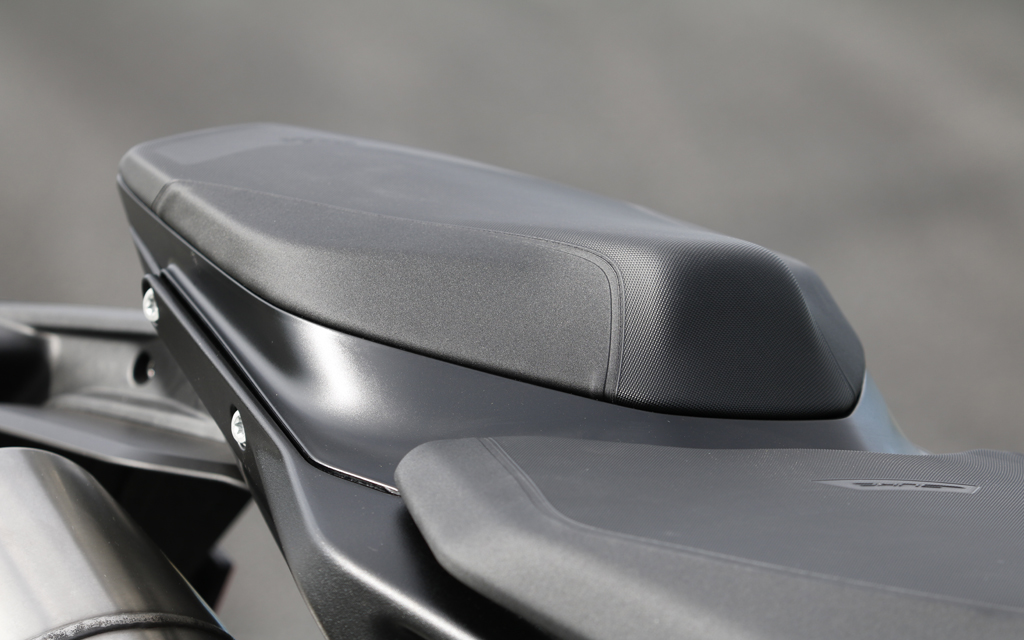
This position makes city and casual road riding easy. It’s a breeze to get accustomed to the Duke, but it does require a certain period of adaptation for faster riding. Especially if you’re not used to supermotos. On a twisty road or a track, you have to read the racing lines correctly and have a good sense of anticipation. It calls for unrelenting involvement. Laziness and lack of attention are not permitted here.
In city riding, the pilot can easily circulate through dense traffic because the Duke is narrow, light and extremely agile. This machine is instinctive, precise, and it excels at tight manoeuvres, thanks to its excellent turning radius and reasonable weight. A simple push on the bar makes it change direction with surprising ease. And to escape traffic, when the light turns green for example, you can count on its flexible engine with good low- and mid-revs power. The twin responds without lugging from 2,700 rpm and pulls quite nicely from 4,000 to 6,000 rpm. But it’s between 7,000 and 9,500 rpm (where the red zone starts) that it really comes to life and delivers its addictive punch. It really kicks you in the back each time you twist that electronic throttle. Personally, I love that. In this part of the power band, the LC8c is explosive and full of character. It gives a hard time to the rear tire and shock, especially when rushing out of curves. Good thing that the traction control and MSR are there to take care of you. The same goes for the steering damper. In Track mode, you can adjust these parameters and transform the Duke into a very playful machine if you go for the less intrusive settings.
The Duke is also characterized by a fine soundtrack that adds even more fun to the riding experience. The LC8 exhales through a 2-in-1 exhaust that ends up in a muffler delivering a rich and seductive sound, enhanced by the addictive blast of the diabolically efficient Quickshifter. The sputter of the twin when decelerating is absolutely intoxicating.
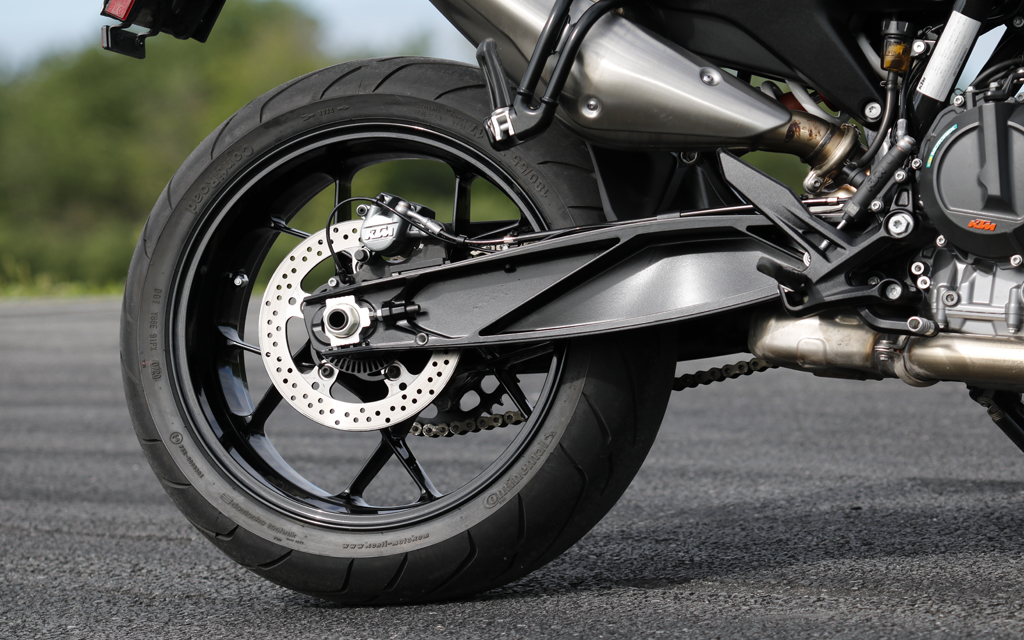
The Duke is at its best on winding secondary roads. The more twisties, the more the KTM shines. Sharp and extremely agile, it’s precise like a scalpel in tight curves and esses. The punch of the engine makes it easy to fly from one turn to another and pick your line with surgical precision. Just push the bar to put the bike on angle, and twist the throttle to exit the curve with strength. The Duke 890 feels rock solid and makes you feel like charging forward. In doing so, you will be helped by the sport/touring Continental ContiRoad tires; they do not offer the exceptional grip of the Michelin Power Cup 2 mounted on the 890 Duke R, which are plain race tires, but they are globally quite efficient. The Contis are confidence inspiring on dry as well as on wet surfaces, though the front end does not deliver as much feedback as the French tires. So you have to be more careful, even if they allow you to reach pronounced lean angles quite safely.
On the highway or on fast roads, the KTM offers average protection and perfectible comfort. That’s not its favourite environment. The same can be said about two-up jaunts. They are recommended only for sado-maso or really-in-love passengers. Minimal rear seat comfort and lack of a grab handle make the ride risky and tiresome. To be used with parsimony. Or to encourage close contact.
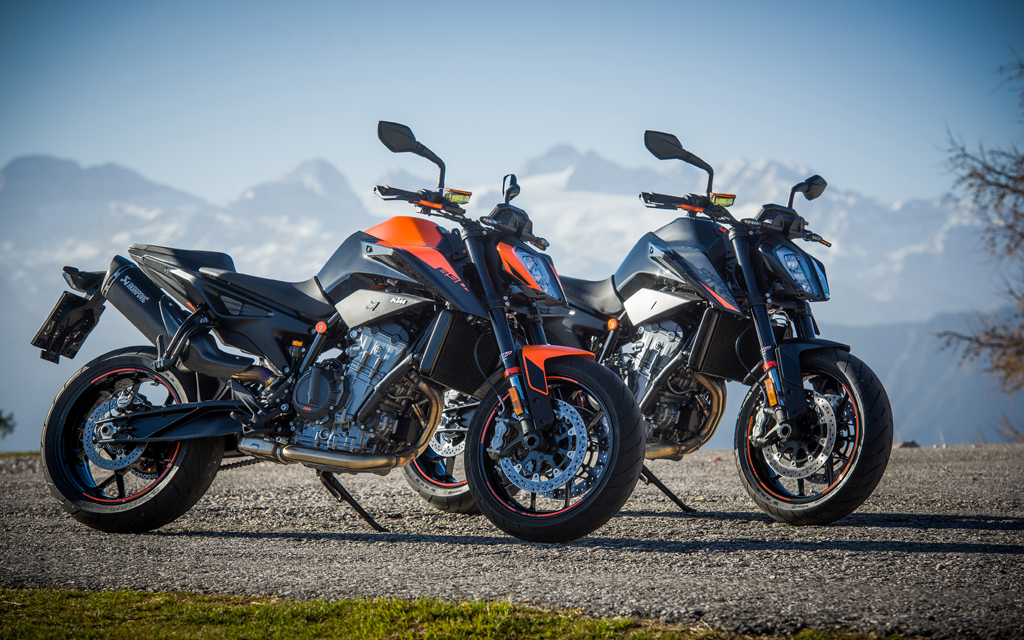
Attacking the track
During this first encounter with the KTM 890 Duke, I have also been invited to try out the new Aprilia RS 660 and Tuono 660 at Autodrome Montmagny, around 90 km southeast of Quebec City. This circuit was created in 1994. At the time, it was a half-mile dirt track. A 3/8-mile asphalt oval was built in 1998. Then, in June 2014, a road race track close to 2 km long, and a 1/8-mile drag race track, were added. The Autodrome de Montmagny is a technical track with two short straight lines, 10 curves—7 to the left, 3 to the right—and a downhill section they call a mini Corkscrew because it reminds you of the famous blind dropping curve of the Laguna Seca track.
With a middleweight roadster, pilots ride in second and third gears most of the time, reaching relatively low speeds (less than 200 km/h).
The speed factor and technical side of this track make it ideal to check the changes brought to the 890 Duke and enjoy its incredible agility.
So I had the opportunity to try the Austrian bike on track and see how it compares to the two Italians. Since my test bike was equipped with the optional Track mode, I picked this setting, selected MSR level 3 out of 9 and Supermoto for braking (ABS disabled at the rear).
The short and technical track is not very fast. On the other hand, it is safe and ideal to give track riding a try or to have fun on a middleweight roadster. It will allow the KTM to demonstrate its liveliness, as well as the vivacity of its engine.
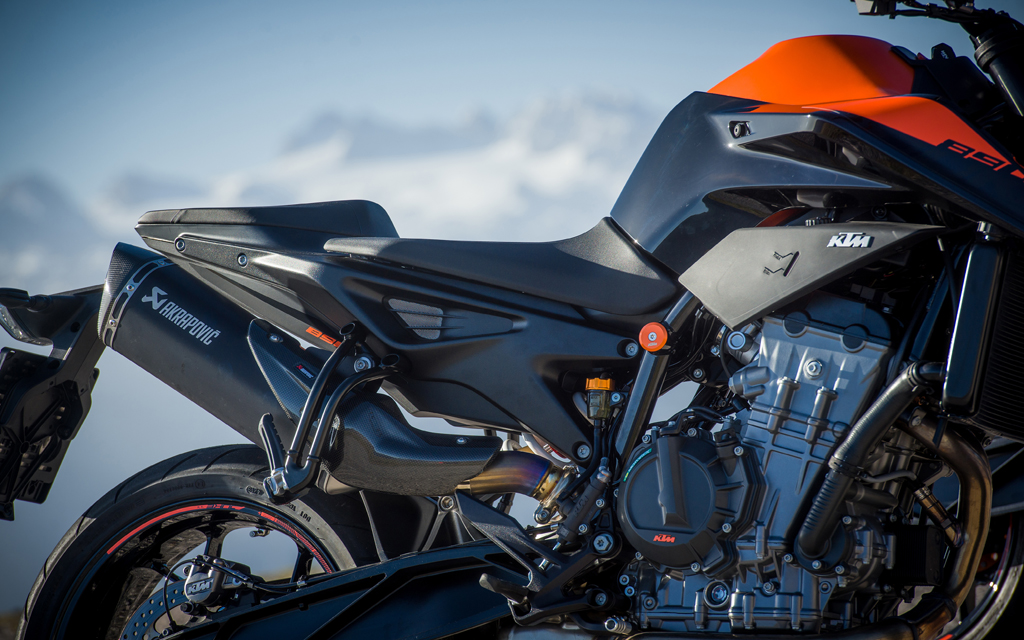
The lightweight and superior agility of the Duke 890 are its main assets for track riding. The machine is narrow between your legs, it goes right where you’re looking and instinctively finds the apex of the curve with a slight push on the bars. This Austrian bike is a surprisingly precise rebel and playful machine that is also forgiving if you make an error, like not picking the right gear going through a curve, for example. It invites you to pilot instinctively. A great toy for grownups!
If you feel like riding aggressively, you can beat up the twin and downshift brutally, at the last minute, without risking locking the rear wheel, because of the antidribble PASC clutch.
The gearbox is excellent. The first three gears are close to generate dynamic acceleration. As for the two-way Quickshifter +, it’s a model of performance and precision. Gear shifting is smooth and precise, with no clutch shifting up or down, which allows you to concentrate on racing lines.
The compliant suspension is not as advanced or efficient as that of the R, on track anyways, but it generally does a pretty good job. For road riding, it offers a good compromise between performance and comfort.
The same can be said of the efficient braking system. It is not as sharp as on the R, but much more so than on the previous 790. The KTM/J. Juan calipers deliver good bite, endurance and modularity. A good compromise for road and track riding. In long curves, with the ABS on and the supermoto mode selected, you can enjoy controlled rear wheel slides and use the trail-braking technique, applying the brake with the bike leaned.
I enjoyed riding the KTM without limitations in this environment. In fact, with sports tires like the Michelin Power Cup 2 of the 890 Duke R, it would make a genuine track bike.
An explosive roadster
The 890 Duke is a significantly more efficient and accomplished machine than the 790 it replaces, especially in terms of suspension, tires and brakes, which are now efficient in road use. It’s the archetypal playful high-performance motorcycle.
KTM says its new Scalpel is the most precise streetfighter you can find. Which would be true if it wasn’t for the 890 Duke R, because, in this specific case, the R is the main competitor of the 890 Duke, and it also happens to be the most precise roadster on the market. The R is more powerful and it has a better suspension and better tires. In fact, if you are considering riding on a track regularly, I would recommend going for the R. It will end up cheaper than modifying the suspension and changing the tires of an 890 Duke, while being a tad faster and sharper.
Compared to its direct competition—Aprilia Tuono 660, BMW F900R, Ducati Monster, Triumph Street Triple 765 RS, Yamaha MT-09—the KTM does more than hold its own. It stands in an enviable position in the universe of middleweight roadsters and it commands respect with its aesthetic and technical approaches.
Its vertical twin engine is one of the most explosive and addictive of the group, along with Triumph’s and Yamaha’s triples, and its chassis is one of the sharpest, along with Ducati and Triumph. And what an agile bike! A real toy!
Since the launch of the original Scalpel four years ago, KTM has found an ideal mix of sportiveness, high-performance, and character. It’s one of the best buys in this category.
SPECIFICATIONS
GENERAL DATA
Dry weight: 169 kg (187 kg wet)
Seat height: 820 mm
Fuel capacity: 14 litres
Fuel consumption: 6 litres/100 km
Fuel range: 230 km
Test duration: 400 km on the road – 6 sessions on the Autodrome Montmagny track
Price: $11,899
Colours: orange/black – black
ENGINE
Engine type: parallel twin, 4-stroke, DOHC, 4-valve per cylinder, liquid-cooled
Maximum power: 115 hp @ 9,000 rpm
Maximum torque: 68 lb-ft @ 8,000 rpm
Displacement: 889 cc
Bore x stroke: 90.7 x 68.8 mm
Compression ratio: 13.5:1
Carburation: electronic injection
Transmission: 6-speed, standard two-way quickshifter
Final drive: chain
CHASSIS
Suspension: WP Apex 43 mm inverted fork, non-adjustable; WP Apex monoshock adjustable for preload only
Wheelbase: 1,482 mm
Rake/trail: 24.3°/99.7 mm
Brakes:
Front – Dual 320 mm discs with radial J. Juan four-piston calipers; Bosch 9.1 MP Cornering ABS, Supermoto mode;
Rear – Single 240 mm disc with J. Juan one-piston caliper. Bosch 9.1 MP Cornering ABS, Supermoto mode
Tires: Continental ContiRoad
120/70ZR17 front
180/55ZR17 rear
What’s different…
Compared to the 790 Duke
Euro 5 engine with more displacement (+ 100 cc)
More power (+ 10 hp)
Extra torque (+ 3 lb-ft)
20% more inertia
Stronger low- and mid-revs
Better suspension
Improved braking (new pads)
Updated electronics
Higher performance tires (Continental ContiRoad instead of Maxxis Supermaxx ST)
Compared to the 890 Duke R
Power down by 11 hp (115 instead 126)
Torque figure down by 5 lb-ft (68 instead 73)
Lower seat (-10 mm)
Continental ContiRoad instead of Michelin Power Cup 2
KTM calipers manufactured by J. Juan instead of Brembo Stylemas
Non-adjustable fork
Monoshock adjustable for spring preload only
No seat hump
